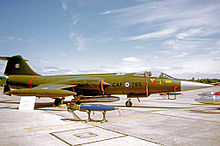| This article needs additional citations for verification. Please help improve this article by adding citations to reliable sources. Unsourced material may be challenged and removed. Find sources: "No. 421 Squadron RCAF" – news · newspapers · books · scholar · JSTOR (February 2012) (Learn how and when to remove this message) |
| No. 421 (Red Indian) Squadron RCAF | |
|---|---|
 | |
| Active | 9 April 1942 to 1945 15 September 1949 to 31 August 1992 |
| Country | |
| Branch | |
| Type | Article XV squadron |
| Part of | unit of the Royal Canadian Air Force, |
| Nickname(s) | Red Indian |
| Motto(s) | Bellicum Cecinere |
| Battle honours | Defence of Britain 1942-43, Fortress Europe 1942-44, France and Germany 1944-45, Normandy 1944 Arnhem Rhine |
| Aircraft flown | |
| Fighter | Supermarine Spitfire de Havilland Vampire Canadair Sabre Canadair CF-104 Starfighter McDonnell Douglas CF-18 Hornet |
No. 421 Squadron RCAF was a unit of the Royal Canadian Air Force. It was the last RCAF fighter squadron to be formed in the UK during World War II.
Establishment
Initially established at RAF Digby in April 1942 with Supermarine Spitfire Mk VA, the squadron moving to RAF Fairwood Common in May and received Spitfire Mk VB.
The squadron's motto was Bellicum cecinere ("They have sounded the war trumpet"). Its badge was, in front of two tomahawks in saltire, a Red Indian warrior.
Second World War

During 1942 the squadron was under 10 Group and flew its mission from RAF Warmwell, RAF Fairwood Common, RAF Bolt Head, RAF Ibsley, RAF Angle, RAF Zeals and RAF Charmy Down. In January 1943 the squadron joined the 127 (Canadian) Wing and moved to Redhill Aerodrome airfield. Late in spring of 1943 the squadron received Spitfire Mk IX and flew under the command of Wing Commander Johnnie Johnson.
In preparation for the Normandy landings the 127 Wing was assigned to RAF Second Tactical Air Force. On June 16 the squadron was along with the other squadrons of 127 Wing the first to be moved to Normandy and flew air superiority missions. After the allied breakout and quick advance towards the Reich 421 squadron was based in Evere in Belgium by October 1944. During December 1944 the squadron received Spitfire XVI. In 1945 the unit participated in the liberation of the Netherlands, before moving into Germany. At the end of the war the unit had achieved over 90 aerial victories.
Postwar


Having been disbanded shortly after the war the squadron was re-activated on 15 September 1949 at Chatham flying Vampire aircraft. It moved overseas flying from RAF Odiham in the UK between January and November 1951. The squadron returned to Canada still flying Vampires from RCAF station St-Hubert until September 1952 when it returned overseas flying Canadair Sabres from Grostenquin, France. In 1962 it was equipped with CF-104 Starfighters and in 1967 the squadron moved to Zweibrücken becoming part of 1 Air Division RCAF (later renamed 1 Canadian Air Group) based at CFB Baden-Soellingen, West Germany. During the early 1980s it was equipped with CF-18 Hornets. At the end of the Cold War the squadron was disbanded and its aircraft and personnel returned to Canada.
References
Citations
- "Bellicum cecinere". TERMIUM Plus® The Government of Canada’s terminology and linguistic data bank. Retrieved 9 April 2018.
- Jefford 2001, p. 92.
- "Canadian and American Squadrons at Headcorn Airfield". BBC. 8 June 2004. Retrieved 28 March 2017.
- "No. 421 Squadron, Canadian Air Force". Archived from the original on 11 December 2013. Retrieved 30 April 2012.
Bibliography
- Jefford, C.G. RAF Squadrons, a Comprehensive Record of the Movement and Equipment of all RAF Squadrons and their Antecedents since 1912. Shrewsbury, Shropshire, UK: Airlife Publishing, 2001. ISBN 1-84037-141-2.
External links
| Squadron numbers |
| ||||||||||||||||||||||
|---|---|---|---|---|---|---|---|---|---|---|---|---|---|---|---|---|---|---|---|---|---|---|---|
| Squadron codes |
| ||||||||||||||||||||||
| Aircraft administered and serviced by the RCAF but manned by the Royal Canadian Artillery.
Non-standard code as unit using OW added L. Letters normally denoted parent Command, aircraft type (L Liberator transport, D Dakota etc), unit, and individual aircraft. VC XX | |||||||||||||||||||||||